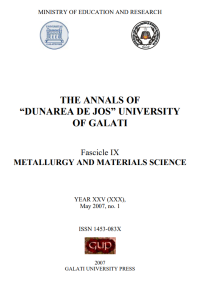Experimental and Theoretical Investigations on Mode I Crack Propagation in Notches under Cyclic Loading
Abstract
Research works regarding crack opening stresses covering various types of Mode I cracks initiated and growing in notches under cyclic loading are shown. A large number of parameters influence the crack opening behavior, i.e. material, crack length, notch geometry, and load amplitude. The experimental results indicate uniform relationships cracks in notches and build the basis for developing improved formulae and algorithms to describe Mode I crack opening behavior. Theoretical calculations of crack opening stresses based on Newman’s equations have been found out to be in good agreement with corresponding experimental data determined from thin, notched specimens subjected to fatigue loading with constant amplitudes.
Downloads
References
[2]. DuQuesnay D.L., Topper T.H., Yu M.T., Pompetzki, M.A., 1992, The effective stress range as mean stress parameter, Int. J. Fatigue, 1, p. 45-50.
[3]. Elber W., 1971, The significance of fatigue crack closure, Damage Tolerance in Aircraft Structures, ASTM STP 486, p. 230-242.
[4]. Ibrahim F.K., 1989, The effect of stress ratio, compressive peak stress and maximum stress level on fatigue behaviour of 2024-T3 aluminium alloy, Fatigue & Fracture Engng Mat. Struct., 12, p. 9-18.
[5]. Masing G., 1926, Eigenspannungen und Verfestigung beim Messing. Proc. 2nd Int. Congress Appl. Mech., p. 332-335.
[6]. McClung R.C., Sehitoglu, H., 1992, Closure and growth of fatigue cracks at notches, J. Engng Mat. Techn., 114, p. 1-7.
[7]. NEWMAN jr J.C., 1984, A crack opening stress equation for fatigue crack growth, Int. J. Fatigue, 24, p. R131-R135.
[8]. Savaidis G., Dankert M., Seeger T., 1995, An analytical procedure for predicting opening loads of cracks at notches, Fatigue & Fracture Engng Mat. Struct., 18, p. 425-442.
[9]. Savaidis G., Seeger T., 1994, An experimental study on the opening and closure behaviour of fatigue surface, corner and through-thickness cracks at notches, Fatigue & Fracture Engng Mat. Struct., 17, p. 1343-1356.
[10]. Schivje J., 1981, Some formulae for the opening stress level. Eng. Fract. Mech., 14, p. 461-465.
[11]. Seeger T., Beste A., 1977, Zur Weiterentwicklung von Näherungsformeln für die Berechnung von Kerbspannungen im elastisch-plastischen Bereich. Kerben und Bruch, VDI-Fortschritt Berichte series 18, No. 2.
[12]. Sun W., 1991, Finite element simulations of fatigue crack closure. Report 159, University of Illinois at Urbana-Champaign.
[13]. Taylor D., 1992, The definition and measurement of crack closure, Eng. Fract. Mech., 16, p. 109-115.
[14]. Vormwald M., Seeger T., 1991, The consequences of short crack closure on fatigue crack growth under variable amplitude loading. Fatigue & Fracture Engng Mat. Struct., 14, p. 205-225.
[15]. Vormwald M., Hertel O., Savaidis G., 2007, Modelling fatigue crack growth in the elastic-plastic regime, Bruchmechanik und Bauteilsicherheit, DVM, Dresden.



